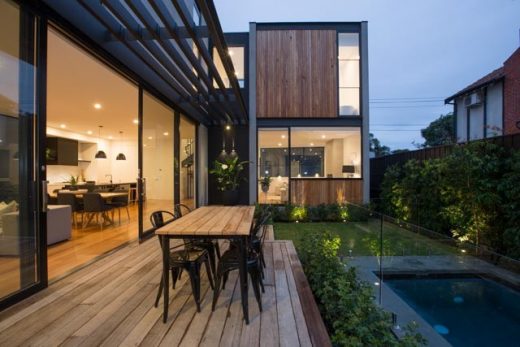Outer Crescent House, Brighton Residence, Australian Home, Architecture Images
Outer Crescent House in Bayside
Residential Development, Brighton design by Merrylees Architecture, Australia
14 Oct 2016
Outer Crescent House, Bayside, Brighton
Design: Merrylees Architecture
Location: Bayside, Brighton, Melbourne, Victoria, Australia
Outer Crescent House
Outer Crescent House is located in the Bayside suburb of Brighton, tucked behind the bustling Bay St shopping precinct. The property was an overlooked transition site measuring a mere 345m2, sandwiched between a commercial warehouse, a lane and the rear of the Bay St shops. The client’s brief was to transcend the small confines of the site and create a large family home with all the trappings of space, style and seclusion the suburb is renown for.
Our design response sought to take advantage of the site’s position between commercial and residential zones, using this as the inspiration for the building’s materiality, orientation and form. Occupying a strong boundary to boundary presence, our concept linked together a series of generous internal living zones to create an oasis of privacy within its light filled spaces.
Elegant sections of vertical and horizontal form connect the home in a dramatic but restrained fashion. The strong, linear masonry external walls form a fortress around the softer timber and glass infill panels of the façade, creating a sense of protection and privacy. A soaring double-height volume with views to the sky greets visitors at the entry, drawing the eye towards the sculptural black steel and timber staircase.
Internally, the design creates a sense of space and light in contrast to the external heaviness of the surrounding commercial fabric. Referencing mid-century modernism, seemingly invisible framing and joinery allows large windows to dominate the aesthetic, leading the eye outward and towards the home’s private garden and entertaining area.
Sustainable design behaviour is one of Merrylees Architecture’s guiding principles. Outer Crescent House is designed to make the most of the site’s orientation, drawing natural light and warmth from the north wherever possible into the house’s main living zones. The challenge with this house was to capitalise on passive solar design while, minimising views into and onto the neighbouring commercial fabric.
Downstairs, we have recessed the living area windows slightly beneath an open pergola structure that provides both privacy and shade when needed. The boundary is heavily planted with mature waterhousia screening trees that create a tranquil outlook with a long-term view of providing additional shade and privacy. Upstairs, the master bedroom is orientated to the north with large eaves and a screened terrace which serves as an overlooking barrier but also meets our objective of creating privacy while still allowing natural light to enter this peaceful room.
Sited in a flood prone area limited our floor structure options to a raised timber floor. To compensate for the lack of thermal mass in the floor, we ensured additional floor insulation was installed to contribute to year round internal comfort. The external walls more than make up for this, being a combination of double insulated brick, Hebel panel, insulated timber cladding and rendered expanded polystyrene.
All windows are double glazed, the main rooms having double hung sashless sliders that allow hot air to escape through the top opening and cool air to ventilate via the lower opening. One advantage of having a raised timber floor in a flood zone is the cavity below is sufficient to house a large rain water collection tank, concealed from the daily occupants while capturing and storing a substantial volume of water to be used for toilet flushing and onsite gardening.
The internal finishes have been carefully selected for their sustainable credentials, with an emphasis on natural products while limiting unnecessary excesses. The overall result is a naturally lit, seemingly spacious and thermally comfortable house than can be inhabited year round without excessive artificial heating, cooling and lighting.
Outer Crescent House in Bayside – Building Information
Design time: 10 months
Construction time: 12 months
Project size: 350 sqm
Project Budget: $1200000
Completion date: Jun 2016
Photography: Tom Wenborne
Outer Crescent House in Bayside images / information received 141016
Location: Bayside, Brighton, Melbourne, Victoria, Australia
Architecture in Melbourne
Melbourne Architecture Designs – chronological list
Melbourne Architect – design studio listings
Kew Building
Lyon Housemuseum
Richmond Terrace
Architects: Robert Nichol & sons

photograph : Lillie thompson
Richmond Terrace Property
Tree House, Kew
Design: Andrew Child Architecture

photo : Rhiannon Slatter
Tree House in Kew
Comments / photos for Outer Crescent House in Bayside page welcome
Website: Merrylees Architecture















